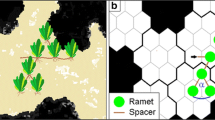Summary
As clonal plants grow they move through space. The movement patterns that result can be complex and difficult to interpret without the aid of models. We developed a stochastic simulation model of clonal growth in the tall goldenrod, Solidago altissima. Our model was calibrated with field data on the clonal expansion of both seedlings and established clones, and model assumptions were verified by statistical analyses.
When simulations were based on empirical distributions with long rhizome lengths, there was greater dispersal, less leaf overlap, and less spatial aggregation than when simulations were based on distributions with comparatively short rhizome lengths. For the field data that we utilized, variation in rhizome lengths had a greater effect than variation for either branching angles or “rhizome initiation points” (see text). We also found that observed patterns of clonal growth in S. altissima did not cause the formation of “fairy rings”. However, simulations with an artificial distribution of branching angles demonstrate that “fairy rings” can result solely from a plant's clonal morphology.
Stochastic simulation models that incorporated variation in rhizome lengths, branching angles, and rhizome initiation points produced greater dispersal and less leaf overlap than deterministic models. Thus, variation for clonal growth parameters may increase the efficiency of substrate exploration by increasing the area covered and by decreasing the potential for intraclonal competition. We also demonstrated that ramet displacements were slightly, but consistently lower in stochastic simulation models than in random-walk models. This difference was due to the incorporation of details on rhizome bud initiation into stochastic simulation models, but not random-walk models. We discuss the advantages and disadvantages of deterministic, stochastic simulation, and random-walk models of clonal growth.
Similar content being viewed by others
References
Angevine MW, Handel SN (1986) Invasion of forest floor space, clonal architecture, and population growth in the perennial herb Clintonia borealis. J Ecol 74:547–560
Batschelet E (1981) Circular statistics in biology. Academic Press, London
Bell AD (1974) Rhizome organization in relation to vegetative spread in Medeola virginiana. J Arnold Arbor 55:458–468
Bell AD (1976) Computerized vegetative mobility in rhizomatous plants. In: Lindenmayer A, Rozenberg G (eds) Automata, Languages, Development. North-Holland Publishing Company, Amsterdam, pp 3–14
Bell AD (1979) The hexagonal branching pattern of rhizomes of Alpinia speciosa L. (Zingiberaceae). Ann Bot London 43:209–223
Bell AD, Tomlinson PB (1980) Adaptive architecture in rhizomatous plants. J Linn Soc, Bot 80:125–160
Bradbury lK (1981) Dynamics, structure and performance of shoot populations of the rhizomatous herb Solidago canadensis L. in abandoned pastures. Oecologia 48:271–276
Bradbury IK, Hofstra G (1976) The partitioning of net energy resources in two populations of Solidago canadensis during a single developmental cycle in southern Ontario. Can J Bot 54:2449–2456
Cain ML (1990a) Models of clonal growth in Solidago altissima. J Ecol 78:27–46
Cain ML (1990b) Patterns of Solidago altissima ramet growth and mortality: the role of below-ground ramet connections. Oecologia 82:201–209
Cain ML (1991) When do treatment differences in movement behaviors produce observable differences in long-term displacements? Ecology 72:2137–2142
Cain ML, Cook RE (1988) Growth in Medeola virginiana clones. II. Stochastic simulation of vegetative spread. Am J Bot 75:730–736
Callaghan TV, Svensson BM, Bowman H, Lindley DK, Carlsson BA (1990) Models of clonal plant growth based on population dynamics and architecture. Oikos 57:257–269
Cook RE (1983) Clonal plant populations. Am Sci 71:244–253
Diggle PJ (1983) Statistical analysis of spatial point patterns. Academic Press, London
Goldberg DE (1988) Response of Solidago canadensis clones to competition. Oecologia 77:357–364
Goodall DW, West NE (1979) A comparison of techniques for assessing dispersion patterns. Vegetatio 40:15–27
Hartnett DC, Bazzaz FA (1985) The integration of neighbourhood effects by clonal genets in Solidago canadensis. J Ecol 73:415–427
Hopkins B (1954) A new method for determining the type of distribution of plant individuals. Ann Bot (London) 18:213–227
Kareiva PM, Shigesada N (1983) Analyzing insect movement as a correlated random-walk. Oecologia 56:234–238
Kemperman JA, Barnes BV (1976) Clone size in American aspens. Can J Bot 54:2603–2607
McCulloch CE, Cain ML (1989) Analyzing discrete movement data as a correlated random-walk. Ecology 70:383–388
Okubo A (1980) Diffusion and Ecological Problems: Mathematical Models. Springer, Berlin Heidelberg New York, Tokyo
Slade AJ, Hutchings MJ (1987) The effects of nutrient availability on foraging in the clonal herb Glechoma hederacea. J Ecol 75:95–112
Smith AP, Palmer JO (1976) Vegetative reproduction and close packing in a successional plant species. Nature 261:232–233
Sutherlad WJ, Stillman RA (1988) The foraging tactics of plants. Oikos 52:239–244
Waller DM, Steingraeber DA (1985) Branching and modular growth: theoretical models and empirical patterns. In: Jackson J, Buss L, Cook RE (eds) Population Biology and Evolution of Clonal Organisms. Yale University Press, New Haven, pp 225–257
Werner PA, Bradbury IK, Gross RS (1980) The biology of Canadian weeds. 45. Solidago canadensis L. Can J Plant Sci 60:1393–1409
Author information
Authors and Affiliations
Rights and permissions
About this article
Cite this article
Cain, M.L., Pacala, S.W. & Silander, J.A. Stochastic simulation of clonal growth in the tall goldenrod, Solidago altissima . Oecologia 88, 477–485 (1991). https://doi.org/10.1007/BF00317709
Received:
Accepted:
Issue Date:
DOI: https://doi.org/10.1007/BF00317709




